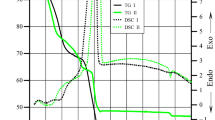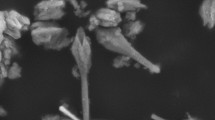Abstract
The thermal decomposition of Prussian blue (iron(III) hexacyanoferrate) under inert atmosphere of argon was monitored by thermal analysis from room temperature up to 1000 °C. X-ray powder diffraction and 57Fe Mössbauer spectroscopy were the techniques used for phase identification before and after sample heating. The decomposition reaction is based on a successive release of cyanide groups from the Prussian blue structure. Three principal stages were observed including dehydration, change of crystal structure of Prussian blue, and its decomposition. At 400 °C, a monoclinic Prussian blue analogue was identified, while at higher temperatures the formation of various polymorphs of iron carbides was observed, including an orthorhombic Fe2C. Increase in the temperature above 700 °C induced decomposition of primarily formed Fe7C3 and Fe2C iron carbides into cementite, metallic iron, and graphite. The overall decomposition reaction can be expressed as follows: Fe4[Fe(CN)6]3·4H2O → 4Fe + Fe3C + 7C + 5(CN)2 + 4N2 + 4H2O.






Similar content being viewed by others
References
Buser HJ, Schwarzenbach D, Petter W, Ludi A. The crystal structure of Prussian blue: Fe4[Fe(CN)6]3·xH2O. Inorg Chem. 1977;163:2704–9.
Ito A, Suenaga M, Ono K. Mössbauer study of soluble Prussian blue, insoluble Prussian blue, and Turnbull’s blue. J Chem Phys. 1968;48:3597–9.
Wilde RE, Ghosh SN, Marshall BJ. The Prussian blues. Inorg Chem. 1970;9:2512–6.
Weiser HB, Milligan WO, Bates JB. X-ray diffraction studies on heavy-metal iron-cyanides. J Phys Chem. 1942;46:99–111.
Allen JF, Bonnette AK. Thermal decomposition of Prussian blue: isotopic labeling with Mössbauer-inactive Fe-56. J Inorg Nucl Chem. 1974;36:1011–6.
Inoue H, Nakazawa T, Mitsuhashi T, Shirai T, Fluck E. Characterization of Prussian blue and its thermal decomposition products. Hyperfine Interact. 1989;46:725–31.
Ludi A, Güdel HU. Structural chemistry of polynuclear transition metal cyanides. Struct Bond. 1973;14:1–21.
Herren F, Fischer P, Ludi A, Hälg W. Neutron diffraction study of Prussian blue, Fe4[Fe(CN)6]3·xH2O. Location of water molecules and long-range magnetic order. Inorg Chem. 1980;19:956–9.
Vaucher S, Li M, Mann S. Synthesis of Prussian blue nanoparticles and nanocrystal superlattices in reverse microemulsions. Angew Chem Int Ed. 2000;39:1793–6.
Fiorito PA, Gonçales VR, Ponzio EA, Córdoba de Torresi SI. Synthesis, characterization and immobilization of Prussian blue nanoparticles. A potential tool for biosensing devices. Chem Commun. 2005;3:366–8.
Shen X, Wu S, Liu Y, Wang K, Xu Z, Lu W. Morphology synthesis and properties of well-defined Prussian blue nanocrystals by a facile solution approach. J Colloid Interface Sci. 2009;329:188–95.
Zhou PH, Xue DS. Finite-size effect on magnetic properties in Prussian blue nanowire arrays. J Appl Phys. 2004;96:610–4.
Karyakin AA, Karyakina EE. Electroanalytical applications of Prussian blue and its analogs. Russ Chem Bull Int Ed. 2001;50:1811–7.
Koncki R. Chemical sensors and biosensors based on Prussian blues. Crit Rev Anal Chem. 2002;32:79–96.
Puganova EA, Karyakin AA. New materials based on nanostructured Prussian blue for development of hydrogen peroxide sensors. Sensor Actuator B. 2005;109:167–70.
Rasmussen PG, Meyers EA. An investigation of Prussian blue analogues by Mössbauer spectroscopy and magnetic susceptibility. Polyhedron. 1984;3:183–90.
Verdaguer M, Girolami G. Magnetic Prussian blue analogs. In: Miller JS, Drillon M, editors. Magnetism: molecules to materials V. Weinheim: Wiley-VCH Verlag GmbH & Co. KGaA; 2005. p. 283–346.
Cosgrove JG, Collins RL, Murty DS. Preparation of ferrous ferricyanide (not Turnbull’s blue). J Am Chem Soc. 1973;95:1083–6.
Zboril R, Machala L, Mashlan M, Sharma V. Iron(III) oxide nanoparticles in the thermally induced oxidative decomposition of Prussian blue, Fe4[Fe(CN)6]3. Cryst Growth Des. 2004;4:1317–25.
De Marco D, Marchese A, Migliardo P, Bellomo A. Thermal analysis of some cyano compounds. J Therm Anal Calorim. 1987;32:927–37.
De Marco D. Thermal analysis of some cyano compounds. Part II. Thermal behaviour of mixed KLnFe(CN)6·4H2O (Ln = La(III), Ce(III), Nd(III)). Thermochim Acta. 1988;128:127–40.
De Marco D. Thermal analysis of some cyano compounds. Note III. The thermal behaviour of Na4Fe(CN)6·10H2O, K2Cu3[Fe(CN)6]2·xH2O, K2Zn3[Fe(CN)6]2·xH2O and Pb2Fe(CN)6. J Therm Anal Calorim. 1989;35:2279–90.
De Marco D, Linert W. Thermal analysis of some cyano compounds. Part IV. The thermal behaviour of LnFe3+(CN)6·nH2O (La = La(III), Ce(III), Pr(III), Nd(III)). Thermochim Acta. 1991;175:249–61.
Brar AS, Sandhu HS, Sandhu SS. Thermal decomposition of hexahydrato thorium(IV) ferrocyanide. Thermochim Acta. 1980;41:253–6.
Lehto J, Haukka S, Koskinen P, Blomberg M. Thermal decomposition of potassium cobalt hexacyanoferrates(II). Thermochim Acta. 1990;160:343–7.
Navarro MC, Lagarrigue MC, De Paoli JM, Carbonio RE, Gómez MI. A new method of synthesis of BiFeO3 prepared by thermal decomposition of Bi[Fe(CN)6]·4H2O. J Therm Anal Calorim. 2010;102:655–60.
Gil DM, Navarro MC, Lagarrigue MC, Guimpel J, Carbonio RE, Gómez MI. Synthesis and structural characterization of perovskite YFeO3 by thermal decomposition of a cyano complex precursor, Y[Fe(CN)6]·4H2O. J Therm Anal Calorim. 2011;103:889–96.
Gallagher PK, Prescott B. Further studies of the thermal decomposition of europium hexacyanoferrate(III) and ammonium europium hexacyanoferrate(II). Inorg Chem. 1970;9:2510–2.
Žák T, Jirásková Y. CONFIT: Mössbauer spectra fitting program. Surf Interface Anal. 2006;38:710–4.
Nomura K, Takeda M, Iiyama T, Sakai H. Mössbauer studies of jarosite, mikasaite and Yapavaiite, and implication to their Martian counterparts. Hyperfine Interact. 2005;166:657–64.
Rodriguez-Carvajal J. An introduction to the program Fullprof 2000 (version July 2001). http://www.ill.eu/sites/fullprof/index.html.
Reguera E, Fernández-Bertrán J. Effect of the water of crystallization on the Mössbauer spectra of hexacyanoferrates (II and III). Hyperfine Interact. 1994;88:49–58.
Reguera E, Fernández-Bertrán J, Balmaseda J. The existence of ferrous ferricyanide. Transit Metal Chem. 1999;24:648–54.
Reguera E, Yee-Madeira H, Fernández-Bertran J, Nuñez L. Mössbauer spectra of ferrous salts of transition metal cyano complexes. A survey. Transit Metal Chem. 1999;24:163–7.
Herbstein FH, Snyman JA. Identification of Eckstrom-Adcock iron carbide as Fe7C3. Inorg Chem. 1964;3:894–6.
Lodya JAL, Gericke H, Ngubane J, Dlamini TH. Synthesis of Fe-carbides species by reactive milling. Hyperfine Interact. 2009;190:37–42.
Yamada Y, Yoshida H, Kouno K, Kobayashi Y. Iron carbide films produced by laser deposition. J Phys Conf Ser. 2010;217:012096.
Fang CM, van Huis MA, Zandbergen HW. Structure and stability of Fe2C phases from density-functional theory calculations. Scr Mater. 2010;63:418–21.
Barton GH, Gale B. The Structure of a pseudo-hexagonal iron carbide. Acta Crystallogr. 1964;17:1460–2.
Niemantsverdriet JW, van der Kraan AM, van Dijk WL, van der Baan HS. Behavior of metallic iron catalysis during Fischer-Tropsch synthesis studied with Mössbauer spectroscopy, X-ray diffraction, carbon content determination, and reaction kinetic measurements. J Phys Chem. 1980;84:3363–70.
Amelse JA, Grynkewich G, Butt JB, Schwartz LH. Mössbauer spectroscopic study of passivated small particles of iron and iron carbide. J Phys Chem. 1981;85:2484–8.
Le Caër G, Dubois JM, Pijolar M, Perrichon V, Busslère P. Characterization by Mössbauer spectroscopy of iron carbides formed by Fischer-Tropsch synthesis. J Phys Chem. 1982;86:4799–808.
Ron M. Iron-carbon and iron-nitrogen systems. In: Cohen RL, editor. Applications of Mössbauer spectroscopy, vol II. New York: Academic Press; 1980. p. 329–92.
Eckstrom HC, Adcock WC. A new iron carbide in hydrocarbon synthesis catalysis. J Am Chem Soc. 1950;72:1042–3.
Cohn EM, Hofer LJE. Mode of transition from Hägg iron carbide to cementite. J Am Chem Soc. 1950;72:4662–4.
Acknowledgements
This study has been supported by the Operational Program Research and Development for Innovations—European Regional Development Fund (CZ.1.05/2.1.00/03.0058), the internal IGA grants of Palacky University (PrF_2010_010, PrF_2011_013), the projects of the Ministry of Education of the Czech Republic (1M6198959201 and MSM6198959218), and the project of the Academy of Sciences of the Czech Republic (KAN115600801). The authors would like to thank to Jan Filip for XRD measurements, Martin Heřmánek for TG measurements, Jana Ševčíkova for Mössbauer measurements, Oldřich Schneeweiss for his comments on carbide phases, and Jiří Tuček for language corrections.
Author information
Authors and Affiliations
Corresponding author
Electronic supplementary material
Below is the link to the electronic supplementary material.
Rights and permissions
About this article
Cite this article
Aparicio, C., Machala, L. & Marusak, Z. Thermal decomposition of Prussian blue under inert atmosphere. J Therm Anal Calorim 110, 661–669 (2012). https://doi.org/10.1007/s10973-011-1890-1
Received:
Accepted:
Published:
Issue Date:
DOI: https://doi.org/10.1007/s10973-011-1890-1




